Graye-sur-Mer Churchill Mk IV AVRE Tank
Unlike a lot of the memorial tanks in Normandy this tank is easy to miss. It is not on the main coast road but on a side road that heads towards the beach. There are no signs to point the way to this amazing preserved piece of history that guards the major exit off Juno Beach. AVRE is short for Armoured Vehicle Royal Engineers.
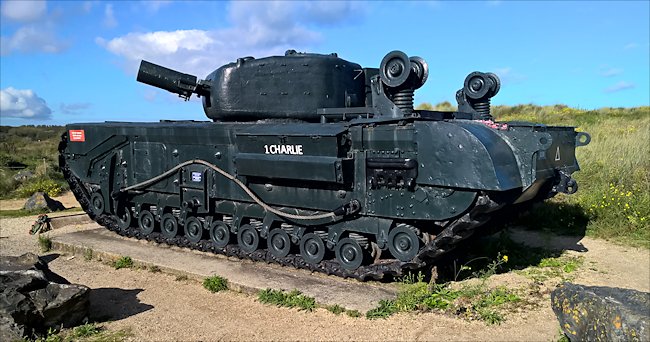
Juno Beach Exit Churchill Mk IV AVRE tank D-Day memorial
Location
Type in the town Graye-sur-Mer into your Sat-Nav then the road Rue de Marine Dunkerque. When you drive into the road follow it down to the end. Head towards the sand dunFamily Photos - USA 2001 Valley of Fires, and the tank can be found where it meets the road Voie Francais Libres.
If your sat-nav cannot find the road when you type in the the seaside village of Graye-sur-Mer try using the nearby town of Courseulles-sur-Mer and then entering the street name. Its location is between the two towns.
The Graye-sur-Mer Churchill Tank
This obstacle-clearance tank called Avenger, belonging to the British 26th Engineer Squadron, landed on the morning of 6th June 1944 D-Day. It sank into a 4 metre deep bomb crater, concealed from its driver by the shallow flooded area that surrounded it. Four members of its 6 man crew were killed by German machinegun and rifle fire as they tried to escape. The other two were seriously injured and had to be evacuated later in the day.
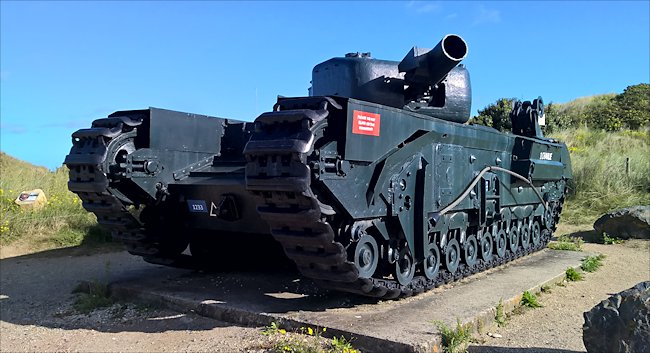
This Churchill Mk IV AVRE tank was designed to get close to fortifications and blow them up with its mortar.
A bridge was built laid over the sunken Churchill tank to allow Allied troops across the flooded land. The tank was used as a bridge support. It remained buried for 32 years. In November 1976 a team of British Army soldiers and engineers extracted the Churchill AVRE tank from its wartime grave. The two surviving members of the tank crew, Tank Driver Bill Dunn and Bill Hawkins, were present when it was lifted back onto the beach. The D-Day tank unit commander General A.E. Younger was also present.
Once it had been restored it was erected on a concrete plinth as a memorial to all the brave soldiers who had died or were wounded on that section of the coast on D-Day. It is situated only a few metres from where it sunk into the large flooded bomb hole.
When Bill Dunn died in 2014 in accordance with his last wishes his ashes were scattered next to his tank, One Charlie on 8th November 2014. There is a small plaque that commemorates this by the side of the tank on a large stone.
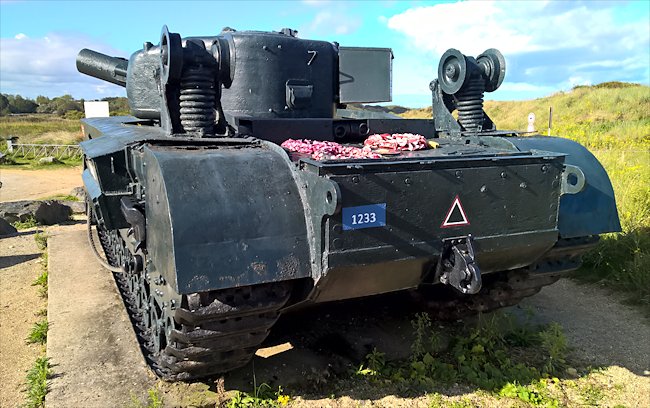
This Churchill Mk IV AVRE tank has two spare track road wheels and suspension springs attached to the track guards.
Specification
The Churchill tank was powered by a Bedford horizontally opposed twin-six petrol engine that produced 350 hp. The tank was very heavy and weighed over 38 tonnes. It was under powered and only had a top road speed of 15mph (24 km/h). It was very thirst for fuel. It only had an operational range of 59 miles (90km) before it needed to refuel.
Its armour was thick in places. It ranged from 16 mm to 102 mm. It normally needed a 5 man crew: commander, gunner, loader/radio operator, driver, co-driver/machine gunner. The AVRE versions of the tank often had a sixth crew member to manage the additional engineering equipment. It was armed with a 290mm Petard Spigot Mortar intended for demolition work. I was also fitted a hull mounted 7.29mm Besa Machine gun.
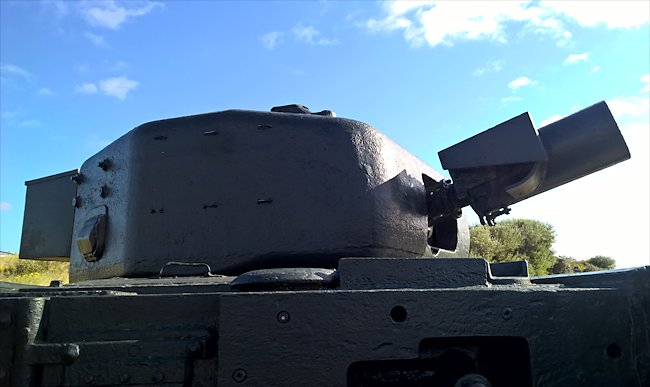
The mortar on the Churchill Mk IV AVRE tank was loaded from the front by the co-driver/machine gunner
Deployment in Normandy 1944
The Churchill Mark IV AVRE was used to carry a fascine bundle of sticks. Some were put on the back decks. This was not usual practice because the hot engine exhausts tended to set fire to the bundle. The normal, but more inconvenient method of carrying them was to put them on the front. This made them easier to drop into an obstacle, but required the commander to sit on top of the bundle with an extended microphone/headset to direct the driver over the intercom. This was not practicable when the tank was under fire. Fascine bundles were used to fill trenches quickly so roads and bridges could be laid on top of them.
The tank had an enlarged co-drivers hatches. This enabled the 290mm Petard Spigot Mortar to be ben down into the open hatch and be loaded. If you look at the pictures of the Mortar you will notice it does not go into the turret. It can only be loaded from the front. This would be difficult to do under machine gun fire so the mortar is on a hinge. When it needs to be loaded the turret is traversed so the mortar is over the hatch. The mortar barrel is depressed downwards and the co-driver loads the round. The hinge is locked back in the horizontal position and the co-driver closes his hatch before it is fired.
If you look closely at the sides of the Churchill Mark IV AVRE tank at Graye-sur-Mer you can see the remains of its dozer arm fittings. In the middle along the side of the tank there appears, what looks like a nozzle. This is what the end of the bulldozer arm would be attached to. Near the front of the tank on its side there is a vertical metal plate that extends down over the track's road wheels. There is a long L shaped piece of metal welded on to it. This would be the guiding arm for the bulldozer blade.
Remember to walk onto the beach and take in the atmosphere of Juno Beach where so many men died. Nearby you will find the Canadian Juno Beach museum, Centre Juno Beach, Voie des Français Libres, Courseulles-sur-Mer.
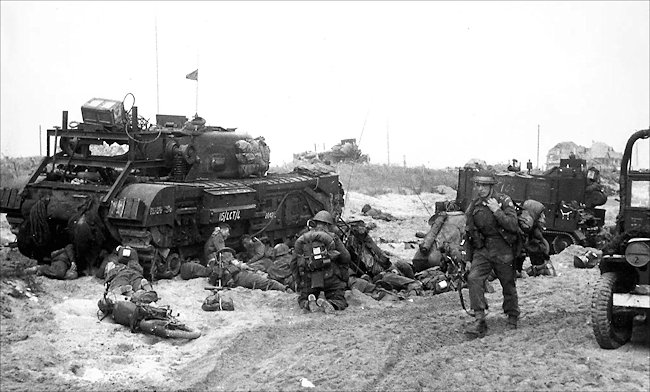
Wounded soldiers taking shelter behind a Churchill AVRE tank on the beach, that has already laid its SGB bridge. You can see the bridge support frame on the back and the spare road wheels.
AVRE Churchill tank on Gold Beach
The 5th Battalion of the East Yorkshire Regiment had a hard fight over on the extreme left-hand side of Gold beach at La Riviére on D-Day, where the concrete defences had survived the shelling. After several armoured vehicles had been knocked out, an Assault Vehicle Royal Engineers AVRE tank appeared. The forty-pound petard bomb fired from its stubby barrel managed to destroy the emplacement containing the anti-tank gun which had inflicted so many losses
But the East Yorks, amid the dust and smoke from the bombardment, still needed several more hours to clear La Riviöre, house by house. Flame-throwing Crocodile tanks also helped, while the flail tanks of the Westminster Dragoons soon cleared minefields. 'Hobart's funnies' had proved their worth in the face of some British, and American scepticism.
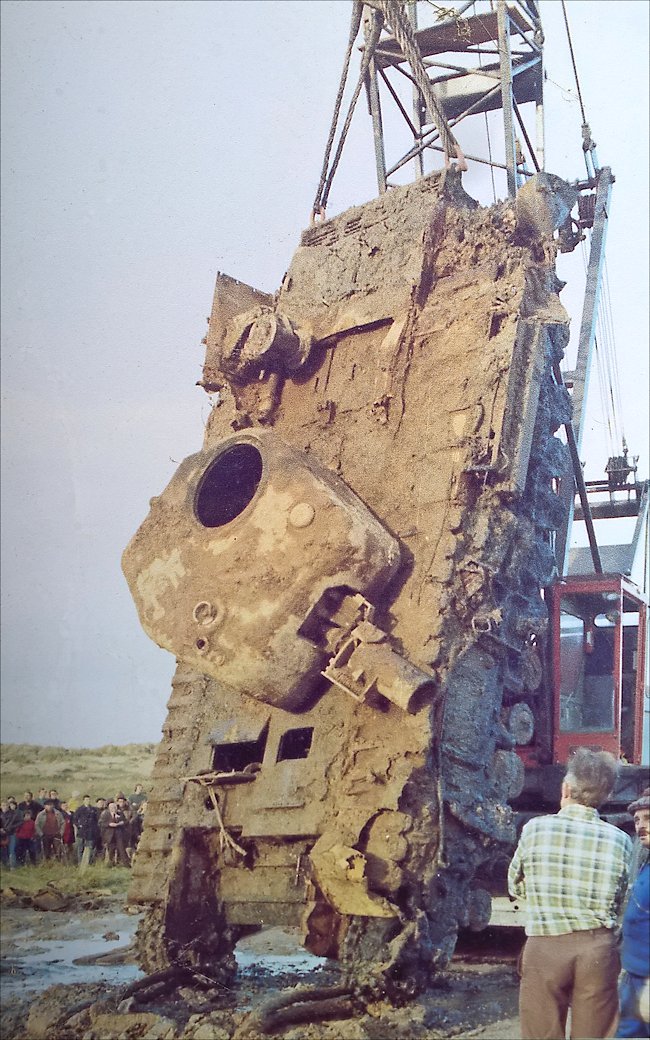
The extraction of the Churchill AVRE tank in November 1976.
D-Day 1944 books

